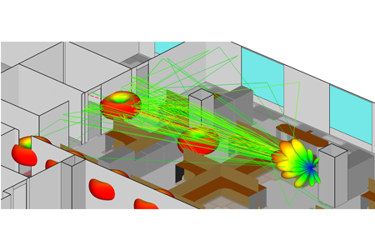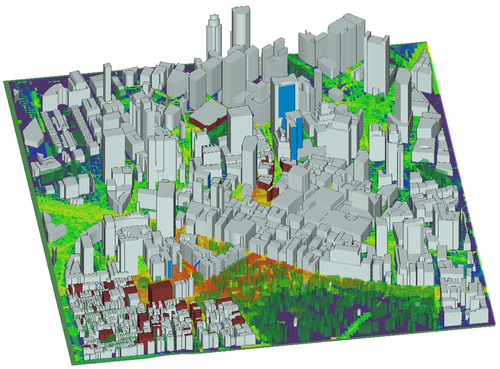Wireless InSite® 3D Wireless Prediction Software

Wireless InSite® is a predictive tool for understanding wireless coverage, channel multipath, and data throughput for 5G, 6G, and WiFi networks.
Through advanced and accelerated 3D ray-tracing and alternative fast ray-based methods and empirical models, it efficiently and accurately predicts multipath channel characteristics in indoor, urban, and rural environments. Dynamic scenario modeling for vehicles and pedestrians captures fading over time, while frequency sweeps incorporate broadband effects. Communications analysis capabilities apply MIMO algorithms to channel predictions to estimate coverage and throughput for wireless networks.
Wireless InSite 3D Wireless Prediction Software Features
Wireless InSite's unique collection of features gives users the ability to analyze even the most complex and massive propagation problems.
Wireless Mobility Create dynamic scenarios with moving vehicles, pedestrians, and handheld or mounted wireless systems. Simulate coverage, multipath, and shadowing as they move through a scene, and determine how their motion impacts wireless connectivity and performance.
X3D Propagation Model X3D is a 3D propagation model with no restrictions on geometry shape or transmitter/receiver height. This accurate model includes reflections, transmissions and diffractions along with atmospheric absorption and diffuse scattering. Supports frequencies up to 100 GHz.
Antenna Modeling Import measured antenna patterns, simulated antennas from XFdtd, or create textbook antennas for use in SISO, MIMO and Massive MIMO transmitter and receivers. Include frequency-specific pattern data to improve accuracy when using multiple bands or performing frequency sweeps.
MIMO Beamforming & Spatial Multiplexing Simulate MIMO antennas for 5G, WiFi and other technologies. Detailed multipath and mutual coupling effects are used with MIMO techniques such as beamforming, spatial multiplexing, and diversity to predict key channel metrics for one or more MIMO data streams.
Communication Systems Analysis Calculate SINR, throughput, theoretical capacity, and bit error rate (BER) to visualize and assess wireless device performance.
Materials Define electrical properties for buildings, terrain, vehicles, and other objects in the scene down to the facet level. The installed materials database includes metal, earth at various moisture levels, concrete, brick, wood, glass, etc. across a range of radio frequencies, including tabulated materials to support multiband analyses.
Engineered Electromagnetic Surfaces (EES) Model an EES or single configuration of a metasurface-based Reconfigurable Intelligent Surface (RIS), and evaluate how it modifies the propagation environment to improve connectivity.
Diffuse Scattering Capture effects of scattering on complex impulse response and received power (including cross-polarization) for mmWave applications.
Scene Geometry Import Load vehicles, objects, and foliage in a variety of standard formats, including KMZ, Collada (DAE), STL, SHP, and DXF. Use Geospatial Data Abstraction Library to import terrain data, including lunar datasets.
Geometry Caching Wireless InSite’s X3D Propagation Model automatically caches processed geometry for later use, avoiding geometry processing time when multiple concurrent or subsequent jobs are run with the same geometry.
Fast Ray-Based Methods 2D site-specific propagation models designed for urban and long-range rough terrain applications.
Empirical Propagation Models Suite of empirical models designed for urban and indoor analysis.
Outputs Users have easy access to outputs including received power, propagation paths, and complex impulse responses. Results can be visualized within dynamic scenarios, plotted along routes or vs. frequency or time, and optionally exported to ASCII or Matlab formats for external post-processing.
Wireless InSite Applications
Wireless InSite provides RF engineers with the tools to design wireless links, optimize antenna coverage, and assess key channel and signal characteristics for RF and millimeter wave frequency bands.
5G MIMO Remcom’s EM simulation software provides a complete 5G solution, from system and MIMO antenna design through performance assessment in realistic, simulated environments, and planning for deployment in 5G networks. Our mission is to provide accurate solutions so customers can reliably predict how their systems will behave in the real world.
Antenna Placement Remcom’s antenna modeling software tools ensure proper design and placement of antennas in almost any application. Our simulation tools can work alone or together for a complete analysis of how an antenna will perform.
Mobile Device Precision is key when designing today’s complex mobile devices, and engineers can’t afford discrepancies between device efficiency and simulation results. Remcom users see less than a 0.5 dB difference in device efficiency when compared to electromagnetic simulation results.
Wireless Propagation Remcom's solutions for wireless propagation applications range from military defense to commercial communications. In addition to our wireless prediction software tools, our Propagation Software Division specializes in government contracting, developing custom software, and performing research and analysis.
Lunar Remcom partners with NASA to simulate wireless links on the Moon. Model antenna performance, coverage, and signal behavior in extreme lunar conditions.
